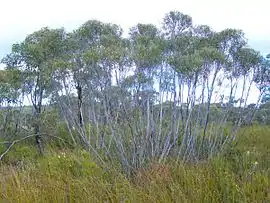Mallee (habit)
Mallee is the growth habit of certain eucalypt species that grow with multiple stems springing from an underground lignotuber, usually to a height of no more than 10 m (33 ft).[1]

Overview
It is most common in plants of the genus Eucalyptus, many of which naturally grow in a mallee habit, and some of which grow as single-stemmed trees initially, but recover in mallee form if burnt to the ground by bushfire. It also occurs in the closely related genera Corymbia and Angophora. The word "mallee" may also be used as a noun in reference to species or individual plants with a mallee habit. The malleefowl is a bird characteristic of this habitat.
Range
Mallees are the dominant vegetation throughout semiarid areas of Australia with reliable winter rainfall. Within this area, they form extensive woodlands and shrublands covering over 250,000 km2 (97,000 sq mi).[2] Thus, mallee woodlands and shrublands are considered one of Australia's major vegetation groups.[2]
Species
Widespread mallee species include:
- E. dumosa (white mallee)
- E. socialis (red mallee)
- E. gracilis (yorrell)
- E. oleosa (red mallee)
- E. incrassata (ridge-fruited mallee)
- E. diversifolia (soap mallee)
An example of a mallee in a high-rainfall area is the rare yellow-top mallee ash, Eucalyptus luehmanniana.
See also
References
- "Habit of Eucalypts". Euclid. Australian National Botanic Gardens. Retrieved 2007-05-06.
- "Mallee woodlands and shrublands" (PDF). Australian National Resources Atlas. Archived from the original (PDF) on 1 October 2003. Retrieved 6 May 2007.